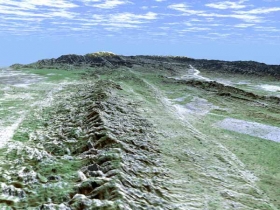 An earthquake is the result of a sudden release of energy in the Earth’s crust that creates seismic waves. The seismicity, seismism or seismic activity of an area refers to the frequency, type and size of earthquakes experienced over a period of time.
An earthquake is the result of a sudden release of energy in the Earth’s crust that creates seismic waves. The seismicity, seismism or seismic activity of an area refers to the frequency, type and size of earthquakes experienced over a period of time.
A new study presents geophysical evidence of fluids (water) migrating into the creeping section of the San Andreas fault that seem to originate in the region of the uppermost mantle that also stimulates tremor, and evidence that along-strike variations in tremor activity and amplitude are related to strength variations in the lower crust and upper mantle. From the pattern of electrical conductivity and seismic activity they were able to deduce that rock water acts as a lubricant.
The San Andreas Fault acts like a seam of the earth, ranging through the entire crust and reaching into the mantle. Geophysicists from the GFZ German Research Centre for Geosciences have succeeded in imaging this interface to great depths and to establish a connection between processes at depth and events at surface. “When examining the image of the electrical conductivity, it becomes clear that rock water from depths of the upper mantle, i.e. between 20 to 40 km, can penetrate the shallow areas of the creeping section of the fault, while these fluids are detained in other areas beneath an impermeable layer”, says Dr. Oliver Ritter of the GFZ. “A sliding of the plates is supported, where fluids can rise.”
The San Andreas Fault is a continental strike-slip fault that runs a length of roughly 810 miles through California in the United States. The fault’s motion is right-lateral strike-slip (horizontal motion). It forms the tectonic boundary between the Pacific Plate and the North American Plate.
While most earthquakes are caused by movement of the Earth’s tectonic plates, water is another major factor. Several activities contribute to this phenomenon: storing large amounts of water behind a dam and drilling and injecting liquid into wells, and by coal mining and oil drilling. Perhaps the best known example is the 2008 Sichuan earthquake in China’s Sichuan Province in May; this tremor resulted in 69,227 fatalities and is the 19th deadliest earthquake of all time. The Zipingpu Dam is believed to have fluctuated the pressure of the fault 1,650 feet away; this pressure probably increased the power of the earthquake and accelerated the rate of movement for the fault.
Source : nature.com




































